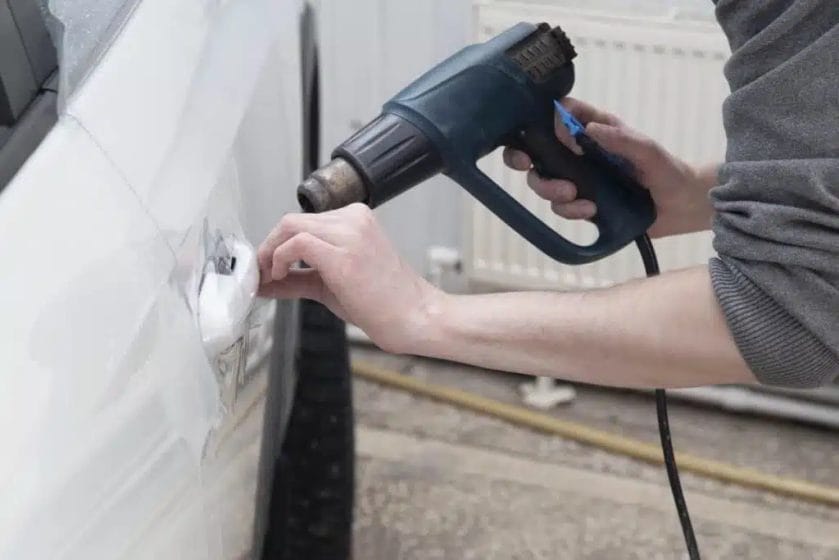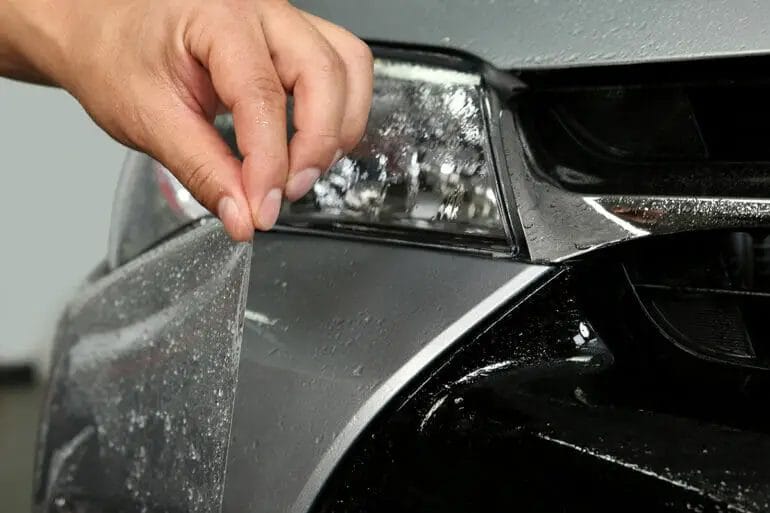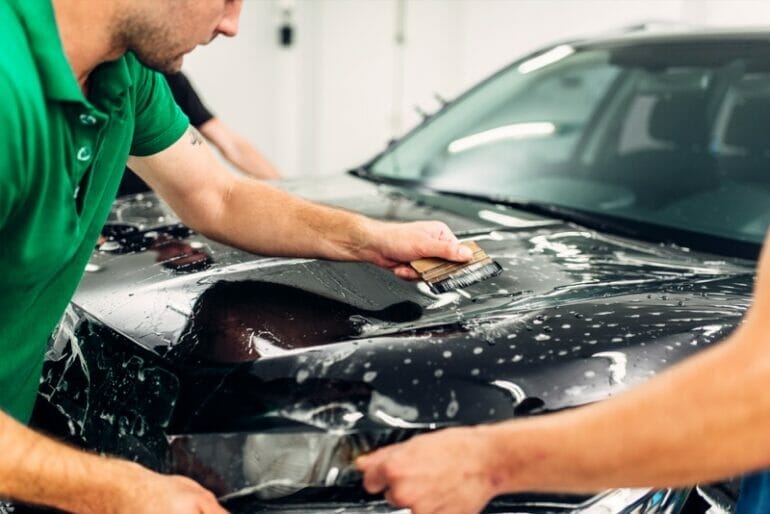If you’re looking for a reliable way to protect your car’s paint from scratches, chips, and fading, installing paint protection film (PPF) is a wise choice. PPF is a transparent, self-healing film that acts as a shield against daily wear and tear. Installing PPF is a straightforward process that involves cleaning the surface, applying the film, and ensuring a smooth, bubble-free finish. With the right tools and techniques, you can easily install PPF and keep your car’s paint looking flawless for years to come.

Choosing the Right Paint Protection Film
When it comes to protecting your car’s paint from scratches, chips, and other damage, paint protection film (PPF) is an essential investment. However, with so many options available in the market, it can be overwhelming to choose the right one for your specific needs. In this guide, we will walk you through the factors to consider when selecting the best paint protection film.
1. Thickness
The thickness of the film is an important consideration as it determines the level of protection it provides. Generally, PPF is available in thicknesses ranging from 6 to 10 mils. Thicker films offer superior protection against rock chips, while thinner films are more flexible and easier to install. Assess the level of risk your vehicle faces and choose the thickness accordingly.
2. Self-Healing Properties
Self-healing properties are a valuable feature in paint protection films. These films have the ability to repair minor scratches and swirl marks automatically when exposed to heat or sunlight. This ensures that your car’s paint surface remains unblemished and maintains its glossy finish over time. Look for PPFs with self-healing capabilities for added durability.
3. Clarity and Gloss
The clarity and gloss of the film are important factors that affect the overall appearance of your vehicle. Opt for a paint protection film with high optical clarity to ensure that it is virtually invisible when installed. Additionally, choose a film that enhances the gloss of your car’s paint, giving it a showroom-like finish.
4. Ease of Installation
Unless you have experience with PPF installation, it is recommended to choose a film that is easy to install. Some films come with advanced adhesive technology that allows for repositioning during installation, making it easier to achieve a seamless finish. Consider the complexity of installation and consult a professional if needed.
5. Durability and Longevity
The durability and longevity of the paint protection film are crucial for long-term protection. Look for a film that is resistant to yellowing, fading, and discoloration, as these factors can impact its effectiveness and appearance over time. Additionally, consider the warranty offered by the manufacturer as an indication of the film’s quality and durability.
6. Maintenance and Care
Consider the maintenance requirements of the paint protection film before making a decision. Some films require special care and specific cleaning products, which can add to the overall maintenance cost. Choose a film that is easy to clean and maintain without the need for elaborate procedures or expensive products.
7. Price
Price is a crucial factor for many car owners when selecting a paint protection film. While it is important to consider your budget, it is equally essential to weigh the cost against the level of protection and the durability of the film. Investing in a high-quality PPF may cost more initially but can save you money in the long run by preventing costly paint repairs.
Choosing the right paint protection film is vital to ensure the long-term beauty and value of your vehicle. Consider factors such as thickness, self-healing properties, clarity, ease of installation, durability, maintenance, and price when making your decision. By selecting the best paint protection film for your specific needs, you can enjoy peace of mind knowing that your car’s paint is safeguarded against damage.

Preparing Your Vehicle for Installation
Before you can install paint protection film on your vehicle, it is important to properly clean and prepare the surface. This will ensure that the film adheres well and provides optimal protection. Follow these step-by-step instructions to prepare your vehicle for installation:
Step 1: Gather the Necessary Supplies
Before you begin the cleaning process, gather all the necessary supplies. You will need:
- Mild car wash soap
- Microfiber wash mitt
- Bucket of water
- Isopropyl alcohol (70% concentration)
- Lint-free microfiber towels
- Plastic razor blade or plastic scraper
Step 2: Wash the Vehicle
Start by washing your vehicle using mild car wash soap. This will remove any dirt, grime, or residue from the surface. Fill a bucket with water and add the car wash soap according to the manufacturer’s instructions. Use a microfiber wash mitt to gently scrub the entire vehicle, including the areas where the paint protection film will be installed. Rinse the vehicle thoroughly and dry it with a lint-free microfiber towel.
Step 3: Remove Any Wax or Sealant
In order for the paint protection film to adhere properly, it is important to remove any wax or sealant from the vehicle’s surface. Apply isopropyl alcohol to a lint-free microfiber towel and gently wipe the areas where the film will be installed. This will remove any wax or sealant residue and ensure a clean surface.
Step 4: Check for Imperfections
Inspect the vehicle’s surface for any imperfections such as scratches, dents, or chips. If you notice any, use a plastic razor blade or plastic scraper to carefully remove any debris or loose paint. Be cautious not to scratch the surface while doing this. It is important to have a smooth and even surface before installing the paint protection film.
Step 5: Clean with Isopropyl Alcohol
Once the surface is free from imperfections, give it a final wipe down with isopropyl alcohol. This will remove any remaining residue and ensure a completely clean surface. Pour isopropyl alcohol onto a lint-free microfiber towel and wipe the areas where the film will be installed. Allow the surface to dry completely before proceeding with the installation.
Step 6: Follow Manufacturer’s Instructions
Lastly, it is important to carefully read and follow the manufacturer’s instructions for installing the paint protection film. Each product may have specific requirements or recommendations for installation. Take the time to understand the instructions and ensure a successful installation.
In summary, preparing your vehicle for paint protection film installation involves thoroughly washing the vehicle, removing any wax or sealant, checking for imperfections, cleaning with isopropyl alcohol, and following the manufacturer’s instructions. By properly cleaning and preparing your vehicle, you can ensure that the paint protection film adheres well and provides optimal protection for your vehicle’s paintwork.

DIY vs Professional Installation
When it comes to installing paint protection film, there are two main options to consider: doing it yourself (DIY) or hiring a professional. Both approaches have their own set of pros and cons, and it’s essential to weigh them carefully before making a decision. In this section, we will explore the advantages and disadvantages of each method to help you make an informed choice.
DIY Installation
Many car owners are tempted to take on the task of installing paint protection film themselves. Here are some potential benefits of the DIY approach:
- Cost Savings: One of the most significant advantages of installing the film yourself is the potential to save money. Professional installation can be quite expensive, especially if you have a large vehicle or opt for higher-quality film.
- Flexibility: DIY installation allows you to work at your own pace and choose the timing that suits you. You won’t have to schedule an appointment or rely on someone else’s availability.
- Learning Experience: Installing paint protection film yourself can be a rewarding experience. It allows you to learn more about your vehicle and gain hands-on knowledge of the installation process.
However, there are also some drawbacks to consider when contemplating DIY installation:
- Time and Effort: Applying paint protection film requires careful precision and patience. It can be a time-consuming process, especially if you have limited experience. It’s important to consider if you have the necessary skills and willingness to invest the effort required.
- Quality and Professionalism: Professional installers have years of experience and access to specialized tools, ensuring a high-quality installation. DIY installation may not result in the same level of finish and durability.
- Mistakes: Without proper training and expertise, there is a higher risk of making mistakes during the installation process. These mistakes can result in bubbles, creases, or uneven coverage, compromising the effectiveness of the film.
Professional Installation
Hiring a professional to install paint protection film offers its own set of advantages and disadvantages. Here are some reasons why you might consider professional installation:
- Expertise and Skill: Professional installers are trained to work with paint protection film and have honed their skills through experience. They know the best techniques to achieve a flawless and long-lasting installation.
- Time-Saving: By entrusting the installation to professionals, you can save a significant amount of time. They have the expertise and tools to complete the job efficiently.
- Guaranteed Results: Reputable professional installers often offer warranties on their work, providing peace of mind knowing that any issues will be addressed.
However, there are also some potential drawbacks to consider when opting for professional installation:
- Higher Cost: Professional installation comes at a price. The cost can vary depending on the size of your vehicle, the quality of the film, and the reputation of the installer.
- Limited Flexibility: You will need to schedule an appointment and work within the availability of the installer. This may not be as convenient as tackling the installation on your own time.
In summary, both DIY installation and professional installation have their own pros and cons. If you have the time, patience, and skills, DIY installation can be a cost-effective and rewarding option. On the other hand, if you value expertise, efficiency, and guaranteed results, professional installation may be the better choice. Consider your priorities, budget, and level of comfort with DIY projects to make the decision that suits you best.
Maintenance and Care Tips
After investing in a paint protection film, it’s important to take proper care of it to ensure its longevity and keep it looking like new. By following some maintenance and care tips, you can protect your vehicle’s paint and preserve the appearance of the film for years to come. Here are some essential guidelines to help you maintain your paint protection film:
1. Regular Cleaning
Regular cleaning is crucial to remove dirt, grime, and other contaminants that may accumulate on the film’s surface. Use a gentle automotive soap or a designated paint protection film cleaner along with a microfiber cloth or sponge. Avoid using abrasive materials or harsh chemicals as they can damage the film. Rinse the film thoroughly with clean water after cleaning to ensure no soap residue remains.
2. Hand Wash Only
When washing your vehicle, always opt for a hand wash instead of an automatic car wash. Automatic car washes often use harsh brushes and high-pressure jets that can cause scratches or peeling of the film. Washing the car by hand allows you to have more control and ensure gentle treatment of the film.
3. Avoid Waxing and Polishing
Paint protection films are designed to provide a glossy finish, and waxing or polishing is generally not required. In fact, using wax or polish on the film can create a hazy or streaky appearance. If you wish to enhance the shine, opt for a specialized paint protection film shine enhancer, which is specifically formulated for use on these films.
4. Mindful Parking
Be cautious when parking your vehicle to prevent unnecessary damage to the paint protection film. Avoid parking too close to objects like trees, bushes, or walls that may scratch or scrape the film. Additionally, be mindful of parking lots with low-hanging branches or areas where construction debris may be present.
5. Protection against Environmental Factors
Protecting your vehicle’s paint protection film from environmental factors can help maintain its appearance. Consider using a car cover when the vehicle is parked for an extended period, especially in outdoor environments with exposure to harsh elements like UV rays, bird droppings, tree sap, and acid rain. Additionally, it’s advisable to avoid driving on gravel roads or in areas with excessive dirt or debris.
6. Regular Inspections
Perform regular visual inspections of your paint protection film to identify any signs of damage or peeling. Look out for scratches, scuffs, or areas where the film may be lifting at the edges. If you notice any issues, address them promptly to prevent further damage and maintain optimal protection.
7. Professional Help for Repairs
If your paint protection film sustains significant damage or begins to peel, it’s best to seek professional assistance for repairs. Attempting DIY fixes may result in further damage and compromise the effectiveness of the film. Professional technicians have the expertise and experience to perform the necessary repairs or replacement, ensuring the continued protection of your vehicle’s paint.
By following these maintenance and care tips, you can extend the lifespan of your paint protection film and keep it looking like new. Remember, proper care and regular inspections are key to preserving the appearance and functionality of the film, allowing you to enjoy long-lasting protection for your vehicle’s paint.
FAQs
1. What is paint protection film?
Paint protection film, also known as PPF, is a clear, self-adhesive film that is applied to the painted surfaces of a vehicle to protect it from scratches, chips, and other damage.
2. How do I install paint protection film?
To install paint protection film, you should clean the surface of the vehicle thoroughly, measure and cut the film to fit the desired area, and then carefully apply it using a squeegee to remove any air bubbles. It is recommended to seek professional installation for best results.
3. How long does paint protection film last?
The lifespan of paint protection film can vary depending on factors such as the quality of the film, the conditions it is exposed to, and how well it is maintained. Generally, PPF can last anywhere from 5 to 10 years before it may need to be replaced.
Conclusion
In conclusion, installing paint protection film is a wise investment to protect your vehicle’s paint from scratches, chips, and other damages. This transparent and durable film acts as a shield, preserving the original paint’s shine and preventing costly repairs in the long run.
By following a few simple steps, you can install paint protection film on your own. First, clean the surface thoroughly and ensure it is free from any dirt or debris. Then, apply the film carefully, making sure to smooth out any bubbles or wrinkles. Finally, trim the excess film and give it a final touch to blend with the rest of the paint.
Remember, proper installation is crucial for optimal performance of the film. If you are uncertain or prefer professional installation, it is recommended to seek the assistance of a trained technician. With paint protection film, you can enjoy a pristine and protected finish for your vehicle, keeping it looking new for years to come.
